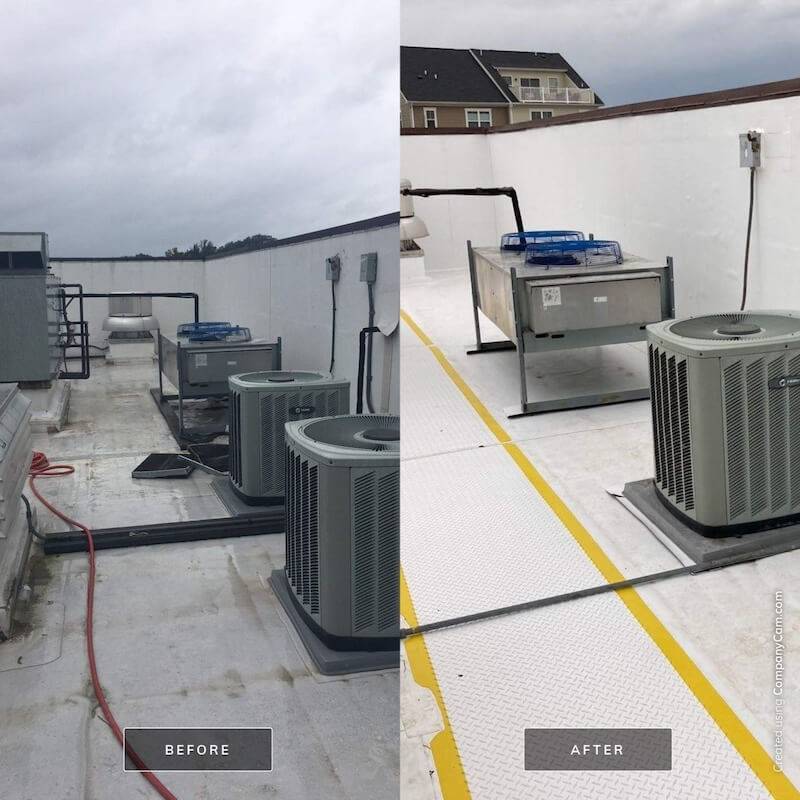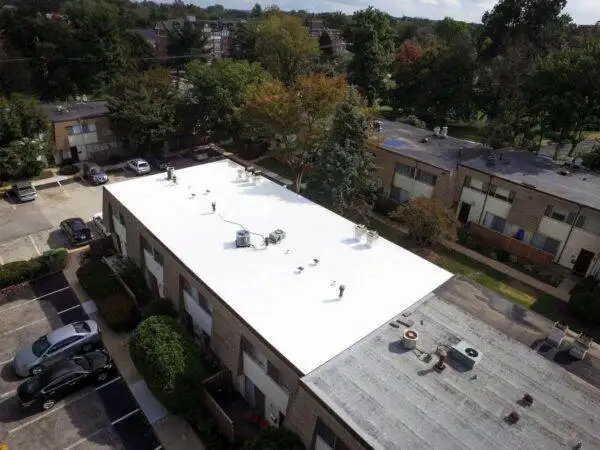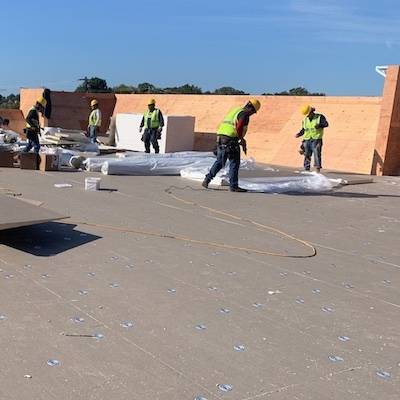Flat roofs have become a fixture across Maryland. From Baltimore rowhomes to Annapolis commercial buildings, their clean lines and practical footprint appeal to property owners who want every inch of usable space. Whether you’re researching for your own building or looking for roofing company you can trust to handle the job right. This guide from RoofPRO spells out exactly how professionals install flat roofing in Maryland, step by step.

Types of Flat Roofing Systems (and Picking the Right One)
Choosing a flat roof system isn’t only about style. Material selection, local codes, insulation, and drainage all play a role. Maryland’s climate means UV rays, freeze-thaw cycles, and humidity can challenge roof performance. That’s why many turn to professionals like RoofPRO, who understand how to build for this region and its weather quirks. Maryland property owners often pick from these common flat roofing systems:
Single-Ply Membranes
- TPO (Thermoplastic Polyolefin): Lightweight, reflective, and easy to weld. TPO is popular for commercial and multifamily buildings in Maryland.
- EPDM (Ethylene Propylene Diene Monomer): Durable and rubbery. Black EPDM absorbs heat (good for winter), while white reflects sunlight (better for energy savings).
- PVC (Polyvinyl Chloride): Chemical-resistant and seam-welded. Used for restaurants or factories where grease or harsh runoff could be an issue.
Built-Up Roofing (BUR)
Built-Up Roofing is made of several layers of bitumen alternated with felt or fabric, then topped with gravel. This old-school system still has a place on historic Baltimore buildings.
Modified Bitumen
Asphalt sheets with modifiers for flexibility and durability. Installed with cold adhesive or torch-down methods.
Spray Polyurethane Foam (SPF)
A seamless, insulating foam sprayed on and coated with an elastomeric top layer. SPF works for complex roofs or where insulation values matter.
Choosing the right system depends on budget, building type, and how the space will be used. RoofPRO often helps clients compare real-world examples, like why TPO might work better on a large commercial building in Columbia, while EPDM fits an Annapolis rowhome’s smaller footprint.

Preparing for a Flat Roof Installation
Here’s what happens before the membrane ever gets rolled out:
Inspect and Clean the Roof Deck
- Sweep, vacuum, and check for spongy spots or damaged wood. Replace any sheathing that flexes or looks stained.
- Remove the old roofing, nails, fasteners, and loose debris. Moisture under old layers leads to rot, so everything has to go.
Repair or Replace Damaged Substrate
- Plywood, OSB, or concrete decks get checked to identify the level. Dips or soft spots get fixed before proceeding.
- Install new roof decking if needed. In areas like Montgomery County, code may require specific thicknesses.
Measure and Plan the Layout
- Map out all roof penetrations (vents, skylights, HVAC units) using chalk lines.
- Check for proper slope (usually at least 1/4 inch per foot) using a long level or laser. If the roof is truly flat, tapered insulation can create slope without structural changes.
Ensure Proper Drainage and Slope
- Double-check that drains, scuppers, or gutters are clear and in the right places.
- Plan for overflow protection if Maryland’s summer storms send more water than expected.
Step-by-Step Flat Roof Installation Process
Flat roofing requires careful layering and attention to detail. Below is the process RoofPRO follows for most membrane systems (TPO, EPDM, PVC). Your exact project might use slightly different steps, but the flow is similar.
Step 1: Install Insulation and Vapor Barrier
- Lay down insulation boards (staggered seams prevent cold spots).
- Add a vapor barrier if moisture migration is a concern, especially on conditioned buildings.
Step 2: Apply Base Sheet or Primer
- Some systems (modified bitumen, BUR) need a base sheet fastened to the deck.
- For single-ply membranes, prime the surface if adhesives will be used.
Step 3: Lay Out the Roofing Membrane
- Roll out membrane across the roof. Let it relax for a few minutes to prevent wrinkles.
- Align edges and use mechanical fasteners, adhesives, or a heat welder, depending on the material.
- Overlap seams per manufacturer instructions, usually 6 to 8 inches for TPO and PVC, 3 inches for EPDM.
Step 4: Secure Seams and Edges
- Use a hot-air welder for TPO or PVC seams. Roll over each seam with a weighted roller to ensure a solid bond.
- For EPDM, apply seam tape or liquid adhesive and press seams tight.
- Finish all edges with metal flashing, termination bars, or seam plates.
- Pay special attention to corners, pipes, and drains, these spots are where leaks often start.
Step 5: Seal Penetrations and Flashings
- Wrap all roof penetrations (vents, HVAC curbs, skylights) with custom-cut membrane pieces.
- Apply extra adhesive and lap sealant for a watertight finish.
- Metal flashings get fastened and sealed at roof edges and walls.
Step 6: Install Protective Surface
- Some roofs need a gravel ballast (BUR) or reflective coating (SPF and some single-ply systems).
- For TPO, EPDM, and PVC, a cap sheet or acrylic coating can extend lifespan.
Step 7: Final Inspection and Leak Testing
- Walk every seam and penetration, pressing or welding again if needed.
- Use a water hose or flood test to confirm no leaks before the project wraps up.
Flat Roof Maintenance Tips After Installation
A flat roof is low-maintenance, but that doesn’t mean no-maintenance. Here’s how Maryland property owners keep flat roofs performing year after year:
- Inspect after storms, especially for ponding water or debris.
- Sweep off leaves, sticks, and trash (fall in Maryland means plenty of both).
- Look for loose seams, bubbling, or signs of wear.
- Check flashings and edges every season.

Why Hire a Professional for Flat Roof Installation?
Flat roofing is a common choice for both homes and commercial properties across Maryland. It offers a sleek appearance, space efficiency, and lower installation costs compared to steep-slope roofs. If you live in an area like Baltimore, Annapolis, or Rockville, you’ve probably seen plenty of buildings with flat roofing systems. The design works well in our region, but installation is not something to take lightly.
DIY roofing can seem appealing, especially with YouTube tutorials everywhere. Here’s why most Maryland property owners choose RoofPRO rather than trying to do it themselves:
- Flat roof warranties depend on proper installation and documentation. Miss a step, and you risk losing coverage.
- Licensed installers know local codes (like those enforced by Montgomery and Anne Arundel counties) and secure all required permits.
- Professional teams spot issues before they become leaks. Because our team checks the underlayment before installation.
- Working on flat roofs above busy streets or active businesses requires harnesses, anchor points, and experience moving heavy materials.
Clients throughout Maryland appreciate RoofPRO’s transparent process and commitment to leaving every jobsite clean and every roof watertight. We don’t rush jobs or skip steps, because that always leads to headaches later.
Frequently Asked Questions About Flat Roofing
Most residential flat roofs finish within several days. Commercial projects run longer based on size, access, and inspections. Weather also affects timelines because welding and adhesives have temperature limits. Your RoofPRO estimator will build a schedule that fits your site and season.
TPO and PVC handle heat well and keep surface temperatures lower in summer. EPDM has strong performance for large retrofits. Modified bitumen serves many retail and multifamily buildings. The right choice depends on drainage, traffic, and budget. A site visit allows a clear recommendation.
Yes, in many cases. Drains need slope to move water. Tapered insulation creates that slope and reduces ponding. It also helps meet energy code targets when combined with flat polyiso. A layout plan shows thickness changes and helps manage cost.
Recover installations are possible when the deck is sound and moisture tests show dry conditions. Many codes limit the number of layers. Edges, drains, and flashings must still meet current standards. We test, document, and propose the right path based on findings.
Plan on twice per year and after significant storms. Keep drains clear and walk pads in place. Small issues found early stay small. RoofPRO offers maintenance plans that track each visit with photos and notes.

